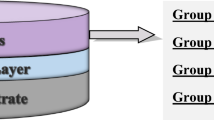Abstract
Removed from the deposition region, an upstream hydrogen microwave plasma etches a surface of solid arsenic located downstream to generate arsenic hydrides. The latter are used with trimethylgallium (TMGa) to achieve low temperature (400–490° C) and low pressure (750 mTorr) homoepitaxial GaAs films. No active or afterglow plasma exists in the growth region. The homoepitaxial growth activation energy of 62 kcal/mole is consistent with the heterogeneous decomposition of TMGa in the absence of arsine. Precursor V-III ratios as low as 0.25 are used to achieve homoepitaxial films, but with high levels of carbon impurities (1019 to mid 1020 cm−3). Carbon incorporation increases at low V-III ratios (0.25 to 0.5) for increasing temperatures with an activation energy of 23 kcal/mole. As the V-III ratios are increased above 1.0, the carbon incorporation activation energy decreases slightly to 15 kcal/mole.
Similar content being viewed by others
References
D. H. Reep and S. K. Ghandi, J. Electrochem. Soc.130, 675 (1983).
M. Uneta, Y. Watanabe and Y. Ohmachi, J. Cryst. Growth,110, 576 (1990).
S. P. DenBaars, B. Y. Maa, P. D. Dapkus, A. D. Danner and H. C. Lee, J. Cryst. Growth77, 188 (1986).
T. R. Omstead, A. V. Annapragada and K. F. Jensen, Appl. Phys. Lett.57, 2543 (1990).
N. M. Johnson, R. A. Street, J. Walker and K. Winer, J. Non- Cryst. Solid114, 169 (1989).
J. Marinace, IBM Research Report No. 11705. See also G. J. Collins, J. R. McNeil, and Z. Yu, U.S. Patent No. 4,952,294, issued 28 Aug. 1990.
M. Naitoh, T. Soga, T. Jimbo, and M. Umeno, J. Cryst. Growth93, 52 (1988).
F. W. Mclafferty and D. B. Stauffer, The Wiley/NBS Regis- try of Mass Spectral Data, (John Wiley and Sons, New York, NY, 1988) Vol. 1.
W. L. Jolly, L. B. Anderson, and R. T. Beltrami, J. Am. Chem. Soc.79, 2443 (1957).
D. Joy, D. Newbury, and D. Davidson, J. Appl. Phys.53, R81 (1982).
K. Tamaru, J. Chem. Phys.,59, 777 (1955).
A. D. Reed, S. S. Bose and G. E. Stillman, Appl. Phys. Lett.,54, 1262 (1989).
Author information
Authors and Affiliations
Rights and permissions
About this article
Cite this article
Pihlstrom, B.G., Sheng, T.Y., Thompson, L.R. et al. Low pressure and low temperature gallium arsenide homoepitaxy employing in-situ generated arsine. J. Electron. Mater. 21, 277–279 (1992). https://doi.org/10.1007/BF02660454
Received:
Revised:
Issue Date:
DOI: https://doi.org/10.1007/BF02660454




